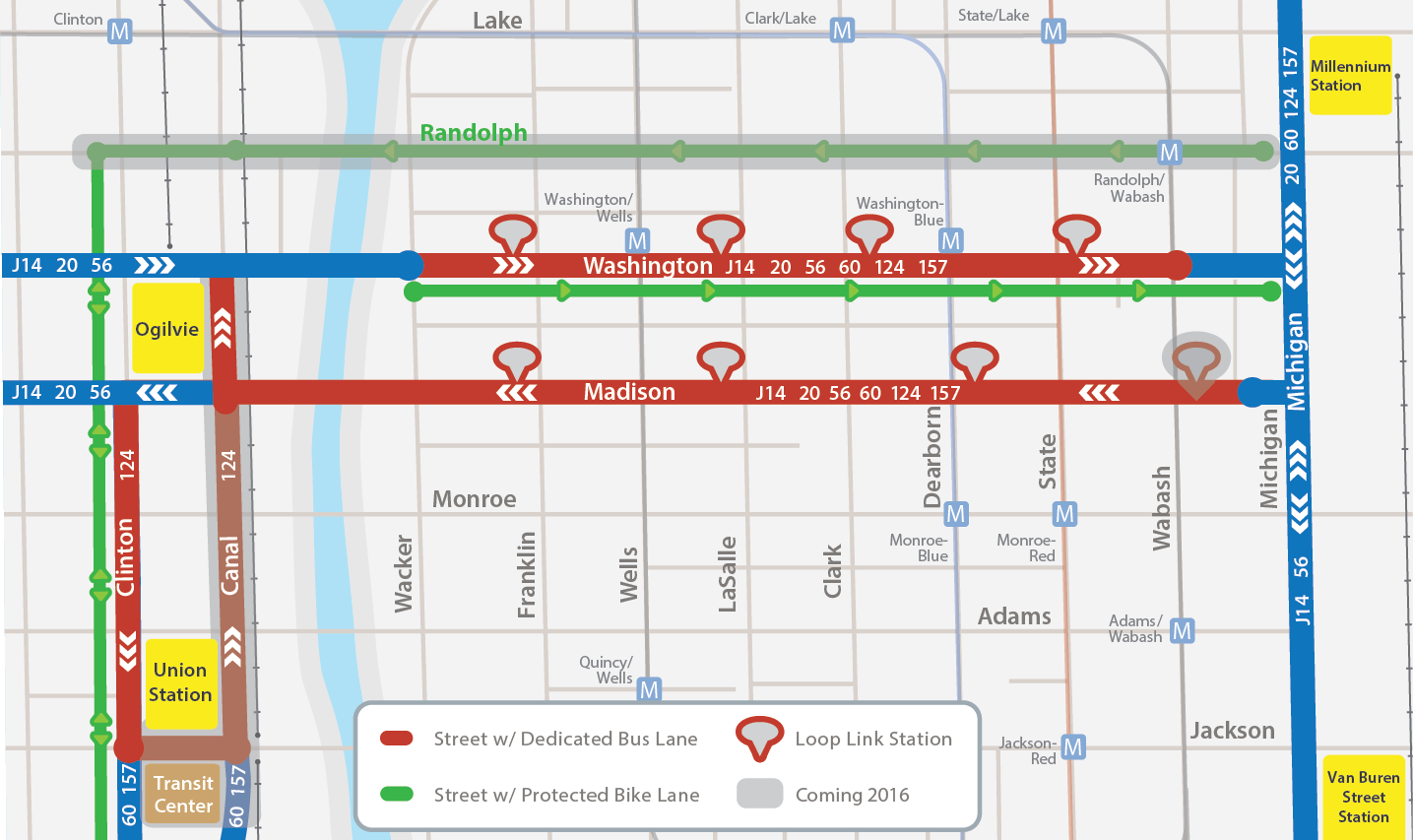This project is complete.
Project overview
Loop Link is a modern transportation upgrade on Washington, Madison, Clinton and Canal that moves people efficiently through the Loop while improving connections between Chicago’s neighborhoods and the jobs and attractions of the central business district. All CTA bus routes that use these streets benefit from dedicated bus lanes and bus-only traffic signals at some intersections to help keep buses separate from general traffic and on schedule. Longer boarding platforms with more seating, shelter, and Bus Tracker screens improve the CTA customer experience.
What are the benefits of Loop Link?
- Connects Chicagoans from neighborhoods across the city to the Loop and provides reliable transit service between the West Loop transportation hubs and Michigan Avenue.
- Expedites bus trips by enhancing the speed and reliability of buses carrying almost 25,000 passengers daily through the Loop and on to all corners of the city.
- Strengthens the economy by improving access to jobs and attractions, while generating more foot traffic to businesses along the route.
- Creates safer streets by organizing travel lanes and reducing conflicts between vehicles, buses, bicyclists and pedestrians.
What are the features of Loop Link?
Link Stations
Stay comfortable and dry with larger covered stations equipped with bus tracking monitors that notify riders when the next bus is arriving.
Raised Platform Boarding
Get on or off the bus with raised platforms that allow passengers to board and exit CTA buses more easily, speeding up the boarding process.
Dedicated Bus Lanes
Stay on schedule with faster and more reliable buses that avoid traffic using dedicated lanes.
Protected Bike Lanes*
Bike comfortably through the Loop using protected lanes with bike traffic signals.
*Protected bike lanes available on Washington and Clinton; additional bike lane on Randolph coming in 2016.
Sidewalk Space
Enjoy more sidewalk space with bus shelters that are located away from walkways.
Who benefits from Loop Link?
Loop Link improves traffic flow downtown by bringing order to the congested streets.
- Pedestrians enjoy more sidewalk space and improved street crossings.
- Buses, which carry nearly half of all travelers on this corridor, use a dedicated bus lane.
- Drivers use two dedicated travel lanes, helping them avoid bus and bicycle traffic.
- Bicyclists use protected lanes on Washington and Clinton to get to their destinations safely. A protected bike lane on Randolph is anticipated to be ready for use in 2016.
Where is Loop Link and what buses use Loop Link?
The Loop Link provides more efficient connections from Union and Ogilvie Stations to Michigan Avenue, using seven bus routes on Washington, Madison, Clinton and Canal that serve neighborhoods across Chicago:
Several other routes will use segments of the Loop Link corridor on Canal Street and Clinton Street.
Map

Lanes indicated as "Coming 2016" have been completed.
When did buses begin using Loop Link?
To begin providing the benefits of Loop Link to commuters and motorists as quickly as possible, CTA buses began using Loop Link bus lanes and boarding platforms on December 20, 2015.
See also